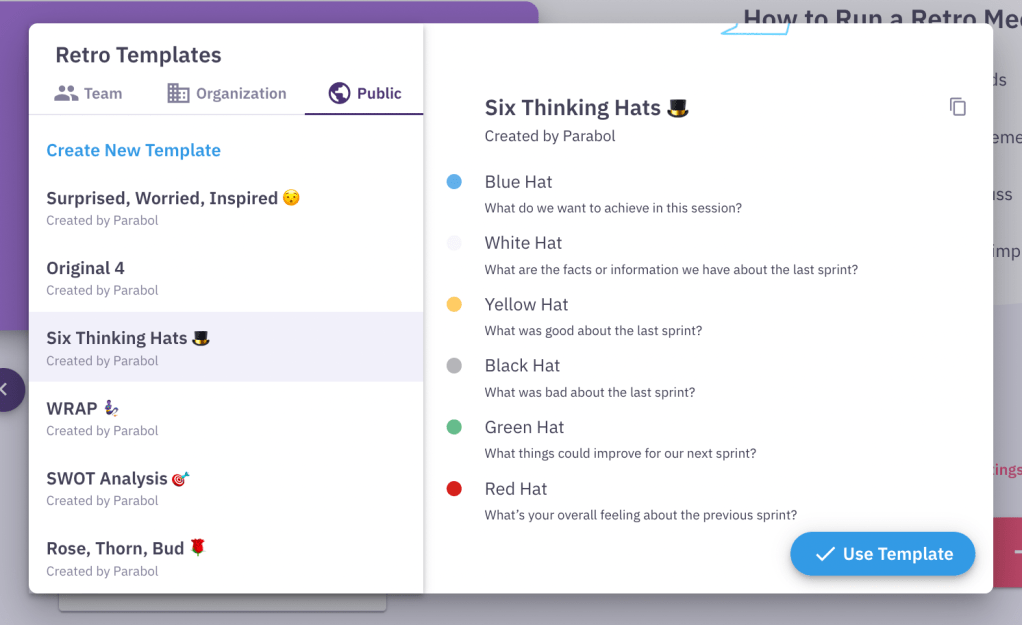Six Thinking Hats Retrospective
A creative method to examine all sides of a situation

What is a Six Thinking Hats retrospective?
The Six Thinking Hats technique is a design thinking framework meant to deepen creative and critical thinking processes.
Created by Edward de Bono, it prompts thinkers to see a situation from different perspectives – offering them a few fun, colorful thinking caps, if you will!
It’s a great critical thinking methodology for agile retrospectives, when we want to think deeply about expectations of the retro, what happened, how successful it was, and why.
This template harnesses several thinking styles that de Bono championed, like lateral thinking and parallel thinking, for stronger decision-making, problem solving, and team collaboration.
Here are the six thinking caps you’ll wear for this retro, and how you’ll use them to guide the discussion.
🔵 Blue Hat
First up is the blue manager’s hat, of organization and goals! What does your team want to achieve with this retro?
The facilitator might want to write these goals down in Parabol or on post-its on a whiteboard if you’re meeting in person.
Example: Let’s talk about how we got work done this year. What strategies, techniques, and processes did we rely on, and how well did they work?
⚪ White Hat
This is the hat of objectivity – think facts, figures, data, and logic.
Keeping it strictly factual, what were the nuts and bolts of this sprint, project, or campaign?
When wearing your white hat, try to give concrete examples of what happened without making judgements.
Example: We didn’t quite reach our goal. But on the deadline, we were 82% of the way there.
🟡 Yellow Hat
Oh yeah! The positive, optimistic one!
What went well, and felt great? What successes, outcomes, or decisions are you proud of, and hope to repeat in the future?
Example: Our client shared that their new website not only felt true to their brand identity, but polished and elevated it beyond their expectations.
⚫ Black Hat
Watch out! Black hat thinking is about all negativity and drawbacks!
What didn’t go well during this project, time period, or sprint? What dragged you down, harming your output or productivity?
Example: When Joyce couldn’t come in on Thursday, no one stepped up to cover for her, and we had to close early.
🟢 Green Hat
Now it’s time for creative thinking. When you put on your green colored hat, get ready to freely associate, dream big, and brainstorm fresh ideas.
What new things could you try for your next sprint? How could you double down on yellow-hat successes, and avoid any more black-hat disappointments? In general, do you have any crazy, experimental ideas you’d like to try out in action?
Example: What if for one week, we tried out working in different teams than usual? What kind of fresh ideas and inspiration could we get?
🔴 Red Hat
Red is the hat of emotion, intuition, and gut feelings.
Overall, how did this experience feel? When you think back on the project, what’s your gut reaction? Try asking people to share words and phrases instinctively, with little analysis or forethought.
Example: Even though we reached our goal, getting there felt sticky and stressful.
When to do a Six Thinking Hats retrospective
This is a very in-depth retrospective. Save these six different hats for when your team wants to be very, very thorough as you reflect on your sprint, project, or nearly anything else.
Big or important projects
The depth of the six thinking hats method makes it great for huge, or super-important projects that require a full review from multiple angles. Six hats might even prove valuable after an experience that felt stressful and challenging, or one that didn’t produce the outcomes you were hoping for.
When working with a new team
With its sequences of hats, this retrospective gives new teams a chance to evaluate their expectations of retrospectives or lessons learned meetings. For teams who have never done these meetings before, discussing the Blue Hat can be helpful.
When you need a thorough post-mortem
Basically, pull out this retro when you need to do a thorough retrospective or post-mortem to gain all the learnings, wisdom, and experience you possibly can.
How to run a Six Thinking Hats retrospective in Parabol
First of all, jump into Parabol. If you’re a Scrum Master or the team meeting facilitator hit the vibrant Add New Meeting button. It’s time to put on your colored hats and get reflecting, just as Dr. Edward de Bono intended.
Select the Six Thinking Hats template
Jump into Parabol and select Retro Meeting with the arrows, then use the dropdown to select the Six Thinking Hats retrospective template. This is where you’ll find Parabol’s library of 40+ retrospective templates.

Feel free to copy and customize your template to add a “Kudos” column if you want to celebrate the work of your team.
Start your Six Thinking Hats activity with an Icebreaker
Every Parabol retrospective begins with an optional icebreaker. This box is checked by default. You don’t have to do one, but we recommend it.
If you’re doing an icebreaker, you’ll have a random question to answer. You can refresh it if you want another option, and of course you can create your own if you want.

After the icebreaker you’ll move on to the reflect stage. This is where your team will brainstorm in silence using the prompts above. All reflections are kept anonymous at this stage to prevent groupthink.
Reflect, Group, and Discuss topics based on Six Thinking Hats prompts
All Parabol sprint retrospectives can be run synchronously or asynchronously. Functionalities such as the timer, voting and multiplayer grouping help you make your retrospective exercise a success and make facilitation easier.
Team members can all leave comments together, or do it at a time that works for them. Also, reflections are anonymous, and no one can see them until you’re done working on them.
After the reflect phase, you’ll vote on issues to discuss, talk about the most voted on items, and set action items for each process improvement so you can make it a reality.
Parabol will send a summary of the retro when you’re done so nobody needs to take notes.